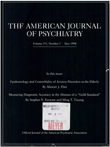Posttraumatic adaptation and distress among adult burn survivors
Abstract
OBJECTIVE: The purpose of this study was to examine the prevalence, natural history, and psychosocial impact of posttraumatic symptoms in adult burn survivors. METHOD: Forty-three adult inpatients at a regional burn center were assessed at discharge with standardized instruments to determine the presence of psychiatric disorder, assess personality, and quantify depression. Thirty-one patients were evaluated 4 months after discharge. RESULTS: Posttraumatic stress disorder was diagnosed in 7% of patients at discharge and in over 22% of patients at follow-up. Symptoms of avoidance and emotional numbing (DSM-III-R criterion C symptoms) tended to emerge after discharge from the hospital. While posttraumatic symptoms were associated with symptoms of depression, they were not strongly associated with psychosocial adjustment to illness; psychosocial adjustment was more strongly related to aspects of personality, the injury itself, and its treatment. CONCLUSIONS: Since adult burn survivors often develop new symptoms of posttraumatic distress after leaving the hospital, longitudinal surveillance is required to detect new cases and provide appropriate treatment. Survivors at risk for poor psychosocial adjustment after discharge may be identifiable during hospitalization, and preventive treatment strategies should be developed and tested for this population.
Access content
To read the fulltext, please use one of the options below to sign in or purchase access.- Personal login
- Institutional Login
- Sign in via OpenAthens
- Register for access
-
Please login/register if you wish to pair your device and check access availability.
Not a subscriber?
PsychiatryOnline subscription options offer access to the DSM-5 library, books, journals, CME, and patient resources. This all-in-one virtual library provides psychiatrists and mental health professionals with key resources for diagnosis, treatment, research, and professional development.
Need more help? PsychiatryOnline Customer Service may be reached by emailing [email protected] or by calling 800-368-5777 (in the U.S.) or 703-907-7322 (outside the U.S.).



